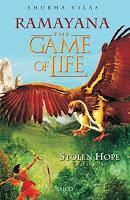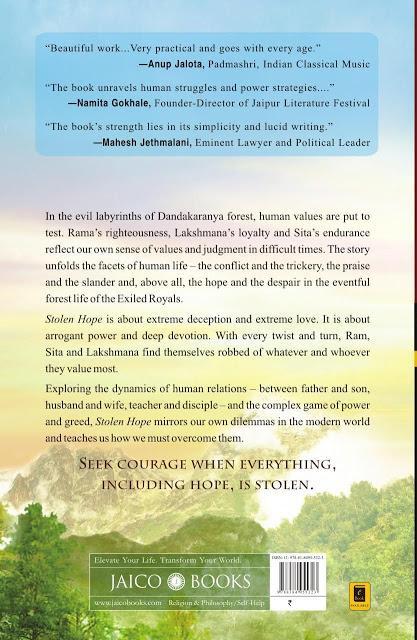 As the reading continues, the deer on the footnote on the page continues to move as well, walking, running, leaping and finally gets attacked by an arrow on the last page. Sometimes, I could relate the state of the deer to the intensity of my absorption into the book. And on the last page, I felt disappointed, like the wounded deer, that the book and mostly, my learning had to come to an end.
As the reading continues, the deer on the footnote on the page continues to move as well, walking, running, leaping and finally gets attacked by an arrow on the last page. Sometimes, I could relate the state of the deer to the intensity of my absorption into the book. And on the last page, I felt disappointed, like the wounded deer, that the book and mostly, my learning had to come to an end. Re-telling Ramayana was a part of the author's intention. Yes, only a part! And the rest was imparting wisdom to the readers about significant nuances of our everyday lives. As a spiritual seeker, it has come naturally to Author Shubha Vilas.
Ramayana: The Game of Life - Stolen Hope is the third of the six Ramayana series by the author.
I haven't read the first two books in the series,Shattered Dreams and Rise of the Sun Prince. Yet, I thought, as an Indian, I fairly knew the plot. Also the first five pages give a brief description of the previous books of the series. True, one can directly dive to the third part, as I did, as far as the story is concerned. However, with respect to the detailed understanding of the Ramayana and the kind of insights the author provides, I think we should take time to go one-by-one in the series.
The book begins with the history of the Dandakaranya forest where Rama, Sita and Lakshmana arrive to spend the years of their exile. The events that follow during their exile are narrated from an intellectual perspective and with admirable interest. A few of the major events include their encounters with Rakshasas, meetings with learned sages like Agastya, Surpanakha's intervention, abduction of Sita and thereafter Rama and Lakshmana's search for Sita whereby they reach Shabari who directs them to Sugriva. Book 4 which is yet to be published shall continue with the rest of their journeys in pursuit of Sita.
Ramayana was all about Ravana abducting Sita and Rama rescuing Sita with the help of Hanuman, before I received the book. I am glad for now I know the intricacies that were involved even before Sita was abducted and the consequences that followed soon after. The many characters and their brief appearances have been justly described. Regardless of whether the reader is a novice or an expert on Ramayana, I think the book shall prove a worthy read to all.
Of all the characters, I admired Sita and Shabari like never before. Places where Sita advices Rama, resists Ravana boldly and as a human how She later regrets for desiring the golden deer were nice reads. Though Shabari appears for a brief period, her role was impressive.
In-between the relay of the events, the author discusses and analyses certain acts of characters. For instance, at one place, Sita boldly reveals Her mind to Rama about choosing the ascetic life instead of his bow and arrow, and immediately the next moment, she could not hold his gaze and begins to stare at Her palms. That is, she feels guilty to have counselled Rama. Here the author discusses Sita's act of giving feedback as follows:
Science of Giving Feedback (Page 45)Giving feedback comes most naturally to human beings. But whether the suggestion is taken positively or as a threat depends on whether one considered three factors before giving feedback.
1. Does one have the right authority to give the feedback?This way, the author relates the stories and characters of Ramayana to the practical wisdom that every one of us need to adapt to.
2. Even if one has the right authority, does one have the right motive to give a feedback?
3. Even if one has the right authority and motive, is it the right time, place and circumstance to give the feedback?
I confess that initially I felt that the footnotes were distracting the continuity of my reading. Now that I've completed, I can say for sure that my learning would have been incomplete without the footnotes. Similar to the discussion mentioned above, short anecdotes about the events are briefed in the footnotes. Almost all carry great meaning. I am quoting my favorite two here:
"To the degree one practices silence in front of those who are genuinely erudite, to that degree that which is concealed is revealed. This is probably why silent and listen are spelled with the same letters.
The art of revealing what is concealed is called teaching." (Page 84)
"When you get what you don't deserve and are grateful, it's called honesty.
When you deserve what you don't get and are still grateful it's called humility." (Page 210)Though on the outside, this book may seem like a hardcore mythological-philosophical combo, in reality I felt like the author is a modern, practical, next door neighbor whose wisdom you will feel comfortable reading about. As a note of suggestion, I like to tell the readers to go slow with the book, grasping points, one at a time, instead of trying to rush within a targeted time period.
To the author and publishers: I have taken the liberty to quote a few phrases from the book here. If it violates any of the copyright laws, please send me a message. I shall oblige to remove them.
Reviewed for the Author
Disclosure of Material Connection: I received this book as a complimentary copy from the author in exchange for a honest review. I was not required to write a positive review. The opinions I have expressed are my own.
My thanks to the author for the signed copy.
Title: Ramayana: The Game of Life - Book 3 - Stolen HopeAuthor: Shubha VilasPublisher: Jaico Publishing House; 1 edition (December 30, 2015)Pages: 296
Author Connect
BlogGoodreadsFacebookTwitter
@Goodreads
Buy Online
TulsiBooksAmazon
About the Author
Shubha Vilas is a spiritual seeker and a motivational speaker. He helps people in dealing with modern-day life situations through the teachings of the Bhagavad Gita, Ramayana and other dharmic traditions. He conducts leadership seminars in premier institutes across the world and inspires deeper human values.
About the Book

